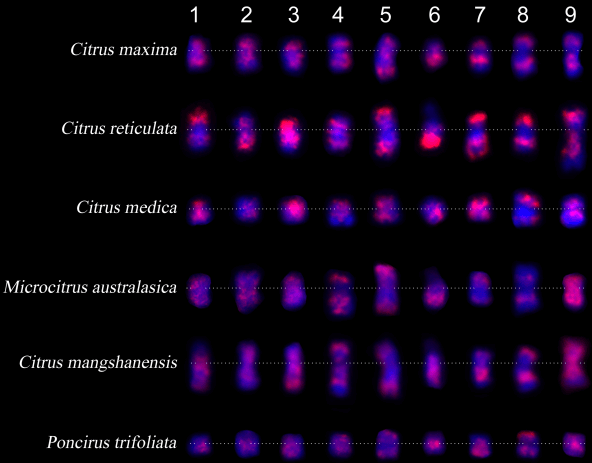Chromosome Synteny and Evolution Assay
Creative Bioarray provides FISH services for analyzing different types of hybrid progeny produced by cross-breeding. Many types of hybrid progeny can be obtained through interspecific and intergeneric hybridization, such as alien gene introgression lines, alloplastic lines, and monosomic alien chromosome substitution lines. Such methods can provide materials useful for the development of practical breeding strategies and the study of the genetic effects of individual chromosomes on plant traits. FISH has become a molecular method to quickly visually analyze the chromosome composition (chromosomal variation) and genome composition of hybrid offspring. The knowledge obtained through analysis can be used to estimate the number of genes controlling traits, describe their linkage relationships, and use this knowledge to genetically improve crops. Our hybrid offspring chromosome drawing service can perform chromosome analysis for different types of hybridization schemes.
Assays of Chromosome Synteny and Evolution
Species cytoplasmic-specific genes affect nuclear-cytoplasmic interactions in interspecies hybrids. Using a set of universal DNA markers to compare genetic linkage mapping is a traditional method for studying homologous chromosomes in different species and their evolution. Reliable identification of individual chromosomes in eukaryotic species is the basis for comparing chromosomal homology and evolutionary studies. But the disadvantage is that it is very time-consuming and depends on the established mapping population. FISH-based mapping provides an alternative method to reveal the homology of homologous chromosomes in different species. The FISH-based method is highly complementary to linkage mapping because it does not require populations and can be completed in a relatively short time. Plotting a set of common BACs on the chromosomes of the meiotic chromosomes of different species proved to be useful for analyzing the chromosomal evolution of species of the same genus. Therefore, BAC-based comparative FISH mapping can use plant single-copy DNA probes for comparative FISH mapping to reveal the evolution of known translocations.
 Fig 1. A case of evolutionary analysis using chromosome painting method. (He L, et al. 2020)
Fig 1. A case of evolutionary analysis using chromosome painting method. (He L, et al. 2020)
Research Applications
Chromosome synteny and evolutionary analyses carried out in the agricultural field provide researchers with the possibility of chromosomal translocation analysis and potential rearrangement discovery in plants of the same genus. This method is usually based on FISH/GISH technology, and sometimes researchers also add gene linkage map analysis. Based on the public BCA probe library, researchers can establish appropriate probe subsets according to their research goals, and then seek customization of probes from companies.
Our technical service platform aims to gradually improve the application services of FISH and provide customers with personalized and customized scientific research service solutions. Through the application of methods such as FISH, researchers expect to discover rearrangement sites that may be useful for hybridization and chromosomal translocation analysis. The FISH testing service covers the entire workflow from the customization of fluorescently labeled probe sets to the mapping of probes to metaphase chromosomes. Our FISH research service will help customers gain more chromosome knowledge.
 Fig 2. Brief workflow of the FISH assay.
Fig 2. Brief workflow of the FISH assay.
Creative Bioarray provides chromosome physical positioning services based on BCA probes. Through this service, customers can analyze chromosomal rearrangements that affect homology, define true homology and homologous sequences to avoid false breakpoints, and can also be used to identify fragment duplication and copy number variation. Through our technology and equipment platform, we can provide you with a rapid turnover analysis of chromosome variation. If you are interested in this scientific research service, please contact us for cooperation. We look forward to cooperating with you in the near future.
Reference
- He L, Zhao H, He J, et al. Extraordinarily conserved chromosomal synteny of Citrus species revealed by chromosome‐specific painting[J]. The Plant Journal, 2020, 103(6): 2225-2235.
All products and services on this website are only suitable for non-medical purposes.


 Fig 1. A case of evolutionary analysis using chromosome painting method. (He L, et al. 2020)
Fig 1. A case of evolutionary analysis using chromosome painting method. (He L, et al. 2020) Fig 2. Brief workflow of the FISH assay.
Fig 2. Brief workflow of the FISH assay.


